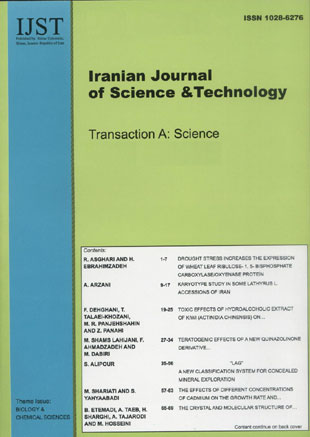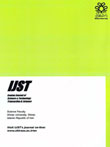فهرست مطالب

Iranian Journal of science and Technology (A: Siences)
Volume:32 Issue: 4, Autumn 2008
- A4
- تاریخ انتشار: 1387/10/11
- تعداد عناوین: 9
-
-
Pages 243-248The purpose of this paper is to introduce the concepts of lacunary strongly Δm-summable and lacunary -statistically convergent of generalized difference sequences of fuzzy numbers. Some results are obtained related to these concepts.Keywords: Lacunary sequence, fuzzy number, difference sequence spaces, statistical convergence
-
Pages 249-260The existing C-30 cyclotron at NRCAM is currently capable of emitting a proton beam with only Emax=30 MeV. To improve this Emax to higher energies of 250 MeV for proton therapy, this beam is injected into the conceptually designed Medical Proton Synchrotron accelerator. Prior to injection, the beam emittances in both x- and y-directions were measured to be ex=1.76´10-5 m.rad and ey = 5.64´10-5 m.rad. The obtained extracted Twiss parameters at the point of injection were; ax =-1.28, bx =12.7, gx =0.21, ay =-0.55, by =3.28, and gy=0.10.The AGILE computer program code was utilized for the lattice design of the Medical Proton Synchrotron. This design is composed of two achromatic arcs. Each arc bends 180° and has a closed dispersion bump.The designed lattice is composed of eight cells each consisting of two Quadrupoles, one Sextupole and two Dipole magnets. The extraction components of sextupole resonance (SR), electrostatic septum (ES) and magnetic septum (MS) were also placed in the designed lattice.The beta functions, as the main parameters of the lattice, have been chosen to meet requirements of the slow extraction. The working point (Qx, Qy) for adjusting the slow extraction were 1.33 and 2.62, respectively. The Hardt condition was met by minimizing the angular dispersion of the separatists corresponding to a different energy spread. The slow extraction of the accelerated particles was also analyzed. The calculation of the slow extraction is performed using the AGILE program. The obtained lattice Twiss parameters of the focusing structure are also presented.Keywords: Beam profile, emittance, wire scanner, proton synchrotron, AGILE, slow extraction
-
Pages 261-273Some sufficient conditions for uniform asymptotic stability of null solution to a certain nonlinear delay differential equation of third order are established. By introducing a Lyapunov functional, a new result is obtained which includes and improves some related results in literature.Keywords: Stability, non, autonomous differential equations with delay, third order
-
Pages 275-281This paper develops a statistical methodology to handle regression of time series data (auto-regressive) with extreme errors. Since in most environmental sciences studies data are gathered in periodic times, this type of data appears more often. An estimation strategy is developed based on regression quantiles to deal with this problem. This is an extension of the Trimmed Least Squares Estimators (TLSE) method to a regression model with auto-regression errors, namely, mixed model. It generalizes the TLSE of regression models to the TLSE of mixed model parameters based on randomly weighted empirical process. It uses regression and auto-regression quantiles. Finally, we apply the results to some air pollution data gathered in Isfahan.Keywords: Regression Quantiles, LSE, JTLSE, air pollution
-
Pages 283-288In this article we introduce the generalized difference paranormed sequence spaces C0(Δn, Λ, p), C(Δn, Λ, p) and l∞(Δn, Λ, p) associated with the multiplier sequence Λ=(λk) of non-zero complex numbers. We study their different properties and prove some inclusion relations.Keywords: Multiplier sequence, paranorm, difference sequence space
-
Pages 289-296In this paper, we apply the Olver’s solution of second order differential equation with the two turning points case. Note that the weight function in this equation has two zeros in the domain, the so called “turning points”. As a basic result we derive the distribution of the eigenvalues with the Neumann boundary conditions.Keywords: Neumann conditions, Sturm, Liouville problem, turning point
-
Pages 305-311This paper deals with Bayesian geostatistical prediction under the Matern correlation function which involves a smoothness parameter in addition to the range parameter. In fact, we consider the reference prior for the range parameter and an inverse gamma prior for the smoothness parameter. We then propose an attractive and straightforward Monte Carlo method to sample the posterior distribution of the model parameters and achieve Bayesian prediction. In a sensitivity analysis, the importance of the prior choice is assessed. Since the posterior results greatly depend on the prior hyperparameters, the Monte Carlo EM algorithm is applied to determine their maximum likelihood estimates. Finally, we utilize this procedure in the geostatistical prediction of carbon monoxide concentrations in Tehran.Keywords: Geostatistics, Bayesian, prior sensitivity, reference prior
-
Pages 313-316Modeling is one of the most fundamental tools used to simulate the complex world. The goal of modeling is to modify a numerical method for updating linear eigenvalues problems to reflect measured spectral information. In this method, we will produce the mass and stiffness matrices.Keywords: Model updating, optimization method, linear pencil


